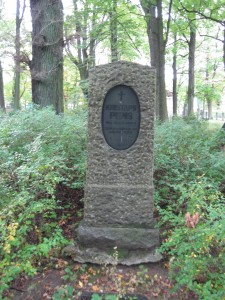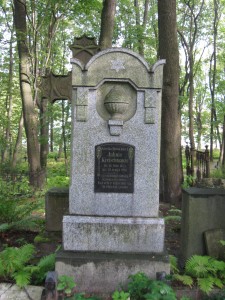I know, I know, it has been a long time since I updated on the Family History through the Alphabet challenge. I was already behind when I joined, now I’m even further behind! But no matter. I will catch up by the end of it!
So, without further ado, Here we have O is for Orthography!
When it comes to Latvian genealogy, orthography can be the trickiest thing for people new to Latvian research, but also the most important. Many people think it is the language, if they don’t know Latvian, German or Russian, then they’re in trouble. But no – I say it is orthography. Why? Well, because if you don’t know how your ancestor’s name is written according to different writing styles, then you won’t even be able to pick them out of a list, never mind be able to read the other information. This is why orthography is most important!
There are at least four different ways that most Latvian surnames can be written. They can sometimes overlap, making only two or three different variations, and sometimes each way can have multiple variations, expanding the number to six or seven. The basic ways are (in rough chronological order): German, Russian, Early Latvian and Modern Latvian. A short chart follows the descriptions.
The earliest records for Latvian genealogical research are predominantly in German. As a result, Latvian names are also written according to German spelling and pronunciation rules. German orthography varies quite substantially from Latvian, since many Latvian sounds are not found in German. German Z would usually stand in for Latvian C, while German S would take the place of Latvian Z. Those are the most common, and also with the potential to be the most confusing – for example, would Zahliht be rendered as Latvian ZÄlÄ«te, preserving the Z, or as CÄlÄ«te, going by usual German-Latvian conversions? Both ZÄlÄ«te and CÄlÄ«te are common Latvian surnames. Another convention of the German era of orthography was the use of “h” after vowels if they were a long vowel – ah would be Latvian Ä, ih for Ä«, and so on. Diacritic marks for sounds not appearing in German – most commonly Ä· and ņ – did start to make an appearance.
Russian orthography presents a completely different challenge from German. The Latvian language has more in common with Russian than it does with German, so the transliteration of sounds isn’t the difficult part, but rather, the different alphabet, since Russian is written in Cyrillic. If you can read the Cyrillic alphabet (don’t be intimidated by it, it really is the easiest part of learning Russian!), then the Latvian names will be relatively easy to pick out more-or-less intact in terms of pronunciation.
“Early Latvian” is what I call the spelling that was used just before independence and right at the beginning of the independent Latvian Republic, before spelling was completely standardized. This was a time of transition, when people were moving from writing and spelling in the old Germanized ways to writing in the new Latvian standardized alphabet, which was adapted from Czech. The most common differences between the Early and Modern Latvian spellings are word endings (the ending “-iņš” would still often be rendered as “-iņ” – though again, not always) and the use of letters not found in the Modern Latvian alphabet (most commonly “w”, which is replaced by “v” in Modern Latvian).
Modern Latvian is what was established during the Latvian Republic between 1918 and 1940, though many newspapers continued to publish in the old Germanized style (complete with blackletter type). If your ancestors emigrated from Latvia in the post-war era, their names are most likely rendered in the Modern spelling. Anytime before the Second World War, however, the name might be written in Early Latvian or German.
For comparison purposes, the ten most common Latvian surnames, in the respective styles… though keep in mind that there might also be more variations in the different categories, I’m only including a few.
| German |
Russian |
Early Latvian |
Modern Latvian |
| Behrsin, Behrsiņ, Behrsiņsch |
Берзин, Берзиньш |
Berziņ, Bersiņ |
Bērziņš |
| Kalnin, Kalniņ, Kalniņsch |
Калнин, Калниньш |
Kalniņ |
Kalniņš |
| Ohsolin, Osolin, Ohsoliņsch |
Озолин, Озолиньш |
Ozoliņ, Ohsoliņ |
Ozoliņš |
| Jannsohn, Jansohn |
ЯнÑон |
Janson |
Jansons |
| Ohsol, Osol |
ÐžÐ·Ð¾Ð»Ñ |
Ozol |
Ozols |
| Leepin, Leepiņ, Leepiņsch |
Лѣпин*, Лѣпиньш*, Лиепиньш |
Liepiņ |
Liepiņš |
| Kruhmin, Kruhmiņ, Kruhmiņsch |
Крумин, Круминьш |
Krūmiņ |
Krūmiņš |
| Balod, Ballohd |
Балод, Ð‘Ð°Ð»Ð¾Ð´Ð¸Ñ |
Balods, Balodis |
Balodis |
| Egliht, Eglit |
Еглит, Ð•Ð³Ð»Ð¸Ñ‚Ð¸Ñ |
Eglīts |
Eglītis |
| Sarin, Sariņ, Sariņsch |
Зарин, Зариньш |
Zariņ |
Zariņš |
*These variations use the old Russian letter “Ñ£” which is no longer in use, but is commonly found in old records. It corresponds to the Latvian “ie”.
So, some rough sound conversions, representing modern Latvian letters/diphthongs… I’ve omitted letters that don’t significantly change.
| German |
Russian |
Early Latvian |
Modern Latvian |
| ah |
а |
ah, Ä |
Ä |
| z, ts |
ц |
c, ts, tz |
c |
| eh |
е, Ñ |
eh, Ä“ |
Ä“ |
| h, ch |
Ñ… |
h, ch |
h |
| ih |
и |
ih, Ä« |
Ä« |
| ee |
ѣ, ие |
ee, ie |
ie |
| ja, ya |
Ñ |
ja |
ja |
| sch, sh |
ш |
sh, Å¡ |
Å¡ |
| uh |
у |
uh, Å« |
Å« |
| w |
в |
v, w |
v |
| s, z |
з |
z |
z |
| zh |
ж |
zh, ž |
ž |
So there you have it! If you have any questions on surnames, don’t be afraid to ask! If you’re not sure from which era your family’s name is from, I can also try to help there!




